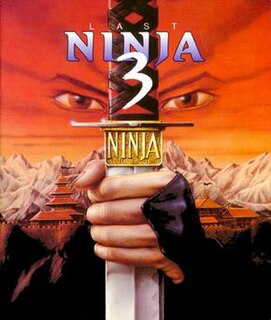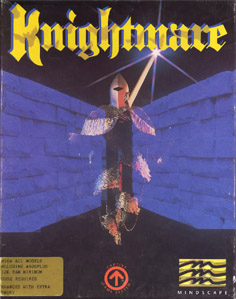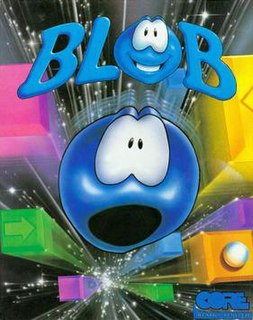
Action-adventure is a video game genre that combines core elements from both the action game and adventure game genres.

The Colonel's Bequest is a character-driven graphic adventure game by Sierra On-Line. It was developed for MS-DOS in 1989. Ports for Amiga and Atari ST were released in 1990. It was the first of the short-lived Laura Bow Mysteries series created by Roberta Williams, which used many elements from the game Mystery House and is known for its lack of discernible point system. The Colonel's Bequest was created with SCI0, and employed 4-bit color and a typing interface. Its sequel The Dagger of Amon Ra was released in 1992.

Oh No! More Lemmings is an expansion pack to the puzzle video game Lemmings by DMA Design. It contains 100 unique single-player levels and six new music tracks. The Amiga version also includes 10 two-player levels. The game requires either the install disk from the previous Lemmings, or, in a standalone version, the game manual, for use as a copy protector. The new levels are separated into five difficulty categories, each with 20 levels.

Atomix is a puzzle video game developed by Günter Krämer and published by Thalion Software, released for the Commodore Amiga and other personal computers in late 1990. The object of the game is to assemble molecules from compound atoms by moving the atoms on a two-dimensional playfield.

Cadaver is an isometric action-adventure game by the Bitmap Brothers, originally released by Image Works in August 1990, for Atari ST, Amiga and MS-DOS. A Sega Mega Drive version was planned but never released. In the game the player controls Karadoc the dwarf.

Rick Dangerous 2 is a platform game developed by Core Design for the Amiga, Atari ST, Amstrad CPC, ZX Spectrum, Commodore 64 and MS-DOS-based PCs. It was released in 1990 and published by Micro Style as a sequel to Rick Dangerous.

Switchblade II is a 1991 side-scrolling action-platform run and gun video game originally developed and published by Gremlin Graphics in Europe for the Amiga home computers. It is the sequel to the original Switchblade, which was solely created by Simon Phipps at Core Design and released earlier in 1989 across multiple platforms. Despite being primarily developed in the UK, its graphics had a distinctly Japanese style similar to anime or manga.

Epic is a space combat simulation game developed by Digital Image Design and published by Ocean Software for the Commdore Amiga and Atari ST in early 1992. A port to MS-DOS also appeared in the same year, followed by a version for the NEC PC-9801 in 1993. A sequel, titled Inferno, was released in 1994 for PCs only.

PGA Tour Golf is a golf video game and the first in the PGA Tour game series. It was developed by Sterling Silver Software and released in 1990, for MS-DOS. It was initially published by Electronic Arts, which subsequently released versions of the game for Sega Genesis and Amiga in 1991, followed by a version for the SNES in 1992. By 1994, Tengen had published versions for Sega's Master System and Game Gear consoles. PGA Tour Golf received generally positive reviews for its realism, sound, and camera. Several critics considered the computer versions to be the best golf game available at the time of its release. It was followed by PGA Tour Golf II.

There have been several video games based on the 1991 film Hook. A side-scrolling platform game for the Nintendo Entertainment System (NES) and Game Boy was released in the United States in February 1992. Subsequent side-scrolling platform games were released for the Commodore 64 and the Super Nintendo Entertainment System (SNES) later in 1992, followed by versions for the Sega CD, Sega Genesis, and Sega's handheld Game Gear console in 1993. An arcade game was also released in 1993.

Football Glory is a 1994 football video game developed by Croteam and published by Black Legend. One or two players compete in football matches viewed from a top-down perspective. The matches and teams are modelled after one of six leagues and cups and take place on varying pitches. The players can perform various moves, including tackles and bicycle kicks, and view instant replays of highlights. The pitch is occasionally invaded by dogs, streakers, hooligans, and police.

Curse of Enchantia is a graphic adventure game developed and released by the British video game company Core Design for MS-DOS and the Amiga in 1992. The game tells the comic fantasy story of Brad, a teenage boy from modern Earth who was magically abducted to the world of Enchantia by an evil witch-queen. Brad needs to escape and take on the forces of darkness to find a way back to his own dimension.

Back to the Future Part II is a 1990 action puzzle video game based on the 1989 film of the same name. It was developed and published by Image Works for Amiga, Amstrad CPC, Atari ST, Commodore 64, DOS, Sega Master System, and ZX Spectrum. The game features five levels based on scenes from the film, and was criticized as a poor conversion of the film. It was followed by Back to the Future Part III.

Last Ninja 3 is an action-adventure video game that was developed and published by System 3 for the Commodore 64, Amiga, Atari ST in 1991. It is a sequel to the 1988 game Last Ninja 2.

Knightmare is a computer game on the Amiga and Atari ST computer systems. It was released in 1991 by Mindscape International Ltd.. The game was written by Tony Crowther. It is based on the Anglia Television TV show Knightmare.

Legends of Valour is a role-playing video game developed by Synthetic Dimensions and released by U.S. Gold and Strategic Simulations in 1992 for the Amiga, Atari ST and MS-DOS, with the additional FM Towns and PC-98 versions in 1993-1994 in Japan only. As the game was planned to be a first part of the series, its full title is Legends of Valour: Volume I – The Dawning. The proposed unreleased sequel to Legends of Valour was to take place in the world outside Mitteldorf, the enclosed city where the entirety of Legends of Valour takes place.

Blob is a puzzle-platform game developed by Jonnathan Hilliard and published by Core Design for the Amiga. It was released in the United Kingdom on September 1, 1993.
Tower of Souls is a 1995 isometric role playing video game by British studio Parys Technografx for Amiga and DOS, and later released for iOS and Windows Mobile.

Terminator 2: Judgment Day is a 1991 action video game developed by Dementia and published by Ocean Software. It is based on the 1991 film of the same name, and was released in Europe for Amiga, Amstrad CPC, Atari ST, Commodore 64, DOS, and ZX Spectrum. The game features several gameplay styles such as driving, fighting, and puzzle-solving.

Die Kathedrale is a 1991 German text adventure game developed by Weltenschmiede and published by Software 2000 for the Amiga and DOS. Die Kathedrale is part of a text adventure trilogy; it is preceded by Das Stundenglas (1990) and succeeded by Hexuma (1992). The trilogy lacks an overarching plot, and in each entry the setting, role of the protagonist, and goal differ between each game. Games in the trilogy do not require knowledge of the other entries and may be played as standalone games.


















